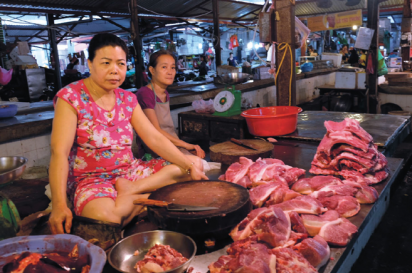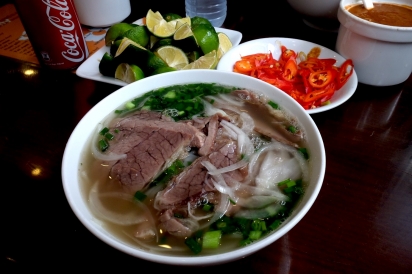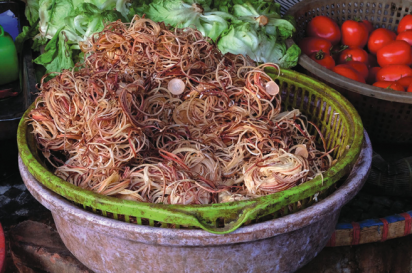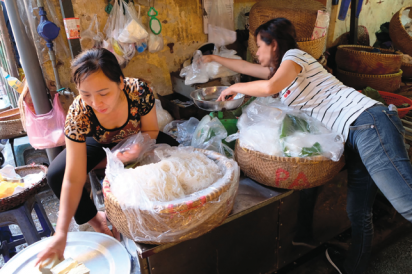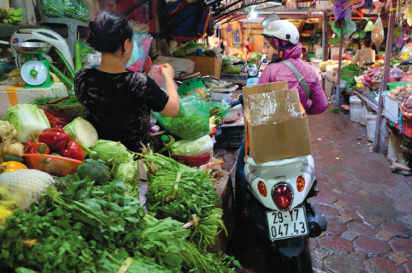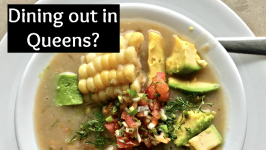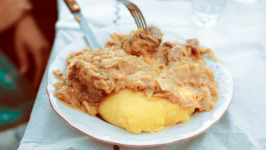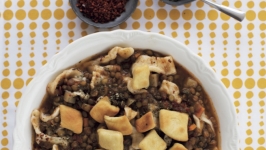A Taste of Hanoi
After a 19-hour haul from New York, and a comparatively quick 50-minute van trip from Noi Bai International Airport to the Hoàn Kiêm District, my two teenagers and I are hungry for a taste of Vietnam. Chaos reigns on Hanoi’s knotty streets. Careening Vespas stand between us and a bowl of noodles. Our guide Linh braces us with a “Ready?” and decisively helps us across the dizzying street.
Sandwiched between Hoàn Kiêm Lake, Long Biên Bridge and the citadel wall lies Hanoi’s Old Quarter. Also known as the 36 Streets, the Old Quarter dates back to the 11th century when, during the Lý dynasty, it was the hub of regional and economic power. Long recognized for its skilled artisans and craftsmen, many of the streets in this bustling part of Hanoi are named after various guilds and trades. Hang Man (street of fish sauce) or Hang Do (silk street) and similar streets are now home to cafés, restaurants and shops selling everything from dresses to helmets to fruits and vegetables. There are stalls offering fresh lychees, mangos and milk fruit. Huddles of shopkeepers peddle chickens, fish and unfamiliar cuts of meat en plein air. A sweaty chef dressed in casual whites busily ladles broth from across the way.
A handful of picnic tables and chairs share the space with the chef and his assistant, along with baskets full of dirty dishes, portioned noodle packages, reused water bottles containing a murky yellow liquid, a frying vat, microwave and tin cash box. A narrow staircase towards the rear of the Đăc Kim restaurant leads us to the cramped dining area upstairs, where a harried waitress, hair haphazardly pinned in an effort to ward off heat, greets us with picture-book menus. An exchange between Linh and our waitress and, as quickly as they appeared, the menus are unceremoniously removed and replaced by spoons, chopsticks and picnic tumblers.
As new customers take their seats, napkins are wrestled from their square-shaped holders, while rims of glasses, tines of forks and tips of chopsticks are meticulously wiped clean. We’re handed individual moist towelettes to wipe our own hands. And then, as if on cue, bowls of pickled cabbage and carrots, garlic and chili, grilled marinated pork and fried rolls are placed before us. The Bun Cha (crab spring roll) and Nem Cua Be (grilled pork with fresh rice noodles) have arrived. Fighting the dump-it-all-in-and-slurp instinct, we gaze imploringly at our guide. Linh systematically fills her bowl with what seem like bitesize portions of each ingredient, finishing with a ladle full of flavorful broth. We follow suit and taste.
Mouthful after mouthful, our palates play with sweet, at times sour, crispy, spicy, crunchy, intriguing, indescribable, minty and fresh flavors. Each item might well stand alone, but their combination is what resounds. Eating the Bun Cha is almost like a game of Goldilocks and the Three Bears. A little of this and it’s too spicy; a little of that and it’s too dry. The act of getting it just right continues until all the bowls are left empty.
Our next stop is a short Vespa ride away; our guide is determined to provide us with as authentic an experience as possible. Carolina, 18; James, 17; and I strap on bright orange helmets and assume the passenger seats behind our affable drivers.
We arrive at Ngu Xã Street in Ba Đinh, a district known for bronze casting, and are greeted by a cheery Vietnamese cook named Dang. She lays out herbs, vermicelli, cooked shrimp, grilled meats and other foodstuffs. Our hands-on lesson in rolling fresh spring rolls called Phở Cuốn begins. The square rice noodle of phyllo-like thinness doesn’t look as if it could hold much. Yet there it is, a veritable war-horse encasing cilantro and lettuce, a sliver of an omelet, stringy rice noodles and a morsel of cooked beef. Care must be taken not to overfill the noodle, and a delicate hand is needed to envelop the filling deftly so that it is all encased and an even-tube-like shape is formed. A tiny dipping bowl holds a thin, light, fiery pepper- and garlic-flavored liquid.
Dipping sauces vary in style and consistency throughout our food excursion depending on use and complementing dishes. They are essential seasoning tools for the Vietnamese as they do not use salt. Their holy triumvirate? Fish sauce, sugar and fresh lime juice, the proper balance of which yields a sublime flavor. Try having a Pho Cuon without dipping, and your mouth will be a sticky mess. Nước chấm, as the seasoned fish sauce is called, delivers the punch that, like Bun Cha, begs you to come back for more. After a full morning of sightseeing, our afternoon begins with a trip to the market and a cooking class at Hanoi Cooking Centre in the Old Quarter.
We meet our instructor, Chef Ouan, and begin class with a walk through one of the many open-air food markets. The market closest to the school is tucked away amid the crowded, winding streets of Hanoi, where sheltered shoppers ramble from stall to stall, dodging pools of murky water and the intermittent moped. We continue around the market picking and choosing, bargaining and rejecting, until we each are carrying a component for the night’s meal.
Back at the school, we divide into groups and prep our menu: a banana-blossom salad, fresh spring roll, ginger chicken and sweet corn rice pudding. Chef explains the history and preparation of each dish before we sharpen our knives and have a go of it. The flower pod crunches as it’s sliced thin and the curls retain their shape. Soaked in acidulated water, banana blossoms become edible nests for cooked shrimp, fresh herbs, minced shallots and a simple vinaigrette combining fish sauce, sugar, shallots, water and hot chilies.
Chef Ouan places a dark green clay vessel, no larger than a cereal bowl and stained from years of service, atop the eight-burner stove. Rich in tradition, Vietnamese food has been influenced by many centuries of colonization—not just by numerous Chinese dynasties, but also by French imperialists and even the Vietnam War or, as the northern Vietnamese refer to it, the American Invasion. While similarities abound, regional differences exist in both preparation methods and ingredients. China itself has a long history of clay pot cooking and first introduced cooking in clay to Hanoi before its use spread throughout Vietnam.
Mai phan (ginger chicken) again uses nước chấm as its base, but this time combined only with sugar. When the sauce is nearly caramelized, sliced shallots, ginger and chilies are added for flavor. Bite-size pieces of chicken thighs are then coated by the thickened liquid and, once cooked through, served over rice. The combination of sweet, salty and spicy again leaves us wanting. These seemingly simple dishes are anything but that. Their strength lies in using the freshest ingredients available and in achieving the proper balance of sweet, salty and heat.
Phở, the broth with noodles that has become the little darling of the urban eater back home, is an early-20th-century invention. During the French colonization of Vietnam, beef consumption was introduced to the Vietnamese, who used cattle primarily for farming rather than as a diet staple. According to a Lucky Peach article (“The History of Phở”) by Vietnamese culinary historian and cookbook author Andrea Nguyen, “Locals hadn’t yet developed a taste for beef, and the butchers had to promote it via special deals and sales.” Clever Vietnamese usurped the French technique of roasting ginger and shallots for flavor, gently boiling marrow-rich beef bones and creating a stock to which they added many different spices including cinnamon, allspice, anise and countless other secrets that both home cooks and chefs hold very close to the vest. From the Chinese tradition, the Vietnamese also incorporated noodles to the flavored broth.
Phở was born and there is nothing simple about it. It is a reflection of a heritage of colonization by both the French and Chinese. It is an important cultural symbol with clear distinctions made as the dish migrated from north to south. In the north, for example, the soup is barely garnished except for, say, a handful of greens, a lime wedge and slivers of hot chili pepper. By the time the soup makes it to the more prosperous south, the garnish expands to include bean sprouts, wider noodles, chili sauce and even soy.
A trip to Vietnam—and, more specifically, to North Vietnam— therefore is incomplete without a bowl of phở. Tucked into the front left of an unremarkable corner storefront in the Old Quarter is the kitchen of 10 Ly Quoc Su, where a handful of cooks hurry noodles, garnish and bowls of steaming broth to feed unrelenting crowds. Incidentally, phở can be made with a variety of meats, not just beef. After the fall of Saigon and during the reunification of Vietnam, beef was scarce, and chicken became its popular understudy.
We order Phở Bo (beef phở). In wooden bowls are what look like Scotch Bonnet pepper slices, thin rice noodles, fresh herbs in the form of mint, cilantro and basil and tiny lime quarters. Scorching-hot individual bowls of broth follow. Garnishes meant to enhance each mouthful are not added willy-nilly to the bowl, but rather systematically added to each spoonful.
It’s hard for me to think about visiting Vietnam outside the context of war. As a child, anti-war protests took place just down the street from where I lived and as a teenager, I marched to demand the release of prisoners of war. And yet, visiting Hanoi now, I find the Vietnam War is barely mentioned. The Hanoi I am experiencing is a youthful, hopeful one, a place of opportunity with a thriving expat community. Not surprisingly, most people we encounter have experienced war only through the stories told by their elders and not from first-hand experiences. To them, that is in the past and they are looking forward.
Hanoi is like the stranger you meet one night at a bar. The music is mellow; the drinks are good. Conversation flows easily, some secrets are revealed, but not too many, and suddenly it’s closing time and you want nothing more than to repeat that night over and over again.
Local Taste: Joju Bowl
For Vietnamese flavors, with a contemporary twist, JoJu Bowl is the way to go. While you can find more traditional Banh Mi sandwiches all across Queens, JoJu Bowl takes the simple yet delicious sandwich, deconstructs it, and puts it back together as a fresh and tasty rice bowl. With a simple menu that doesn’t stray, Joju delivers all the flavor of it’s big brother the sandwich and more.
by Malia Guyer-Stevens
JoJu Modern Vietnamese Sandwiches | @jojubanhmi



